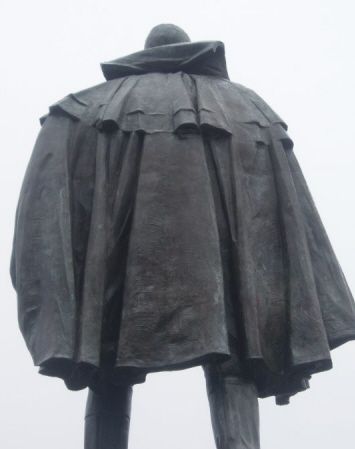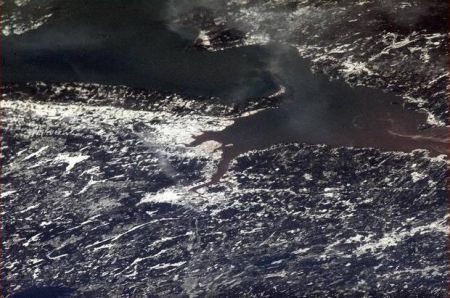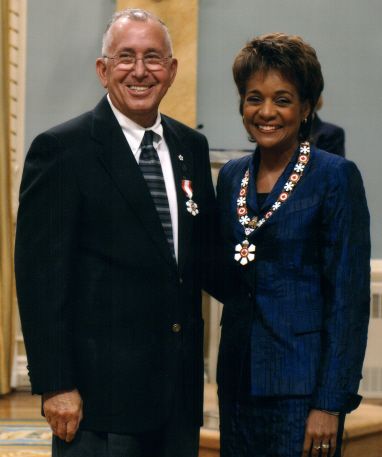
A small group of demonstrators march through Kentville on February 14 to protest the use of Edward Cornwallis' name on public holdings. Photo © Marke Slipp

Portrait of Edward Cornwallis by Sir George Chalmers, Minorca, 1755.

Cornwallis' back! (from Daniel Paul's web site)

The river winds its way for 48 km through eastern Kings County. Photo © Marke Slipp

The tidal river empties into the Minas Basin, under the watchful eye of Blomidon. Photo © Marke Slipp

The Minas Basin and surrounding area. Photo by Chris Hadfield

Southwestern Nova Scotia, showing the development through the Annapolis Valley. The brown areas to the right are the Minas Basin at low tide, where the river empties into.

Daniel N. Paul and Governor General Michaelle Jean. 1st Medallion:Order of Nova Scotia. 2nd Medallion: Order of Canada.
This past Valentine’s Day a determined group of young demonstrators and their parents protested the use of Edward Cornwallis’s name on public places. According to
an article in the local paper, Richelle Brown Redden got the idea for the demonstration when she couldn’t give a good reason to her 10 year-old son Caiden as to why the name of Edward Cornwallis was still so prominent on places like the river that ran through Kentville. In June of 1750 Lieutenant General Edward Cornwallis, the first Governor of Nova Scotia, placed a bounty on the heads — or preferably the scalps — of all Mi’kmaq people in Nova Scotia in order to eradicate them, as they were considered a problem while Colonials took over their traditional lands. Mi’kmaq writer Daniel Paul writes about this in his book,
We Were Not The Savages.
In response to this small-but-enthusiastic demonstration calling for renaming public places names using ‘Cornwallis’, a recent
online opinion piece by Leo Deveau suggested that people “need to get a grip” when it comes to renaming places. The article contained an extensive collection of information about the beginnings of Colonial settlement in Nova Scotia. I found it interesting that an article could contain so many facts yet so little understanding. Although Deveau pleads that Edward Cornwallis not be judged by contemporary standards, he makes no convincing argument regarding
not changing the names of public places — like the Cornwallis River — to something more fitting for contemporary circumstances. History will not be altered due to renaming, as Deveau himself claims. And it is completely legitimate to adjust our way of thinking and behaviour due to new standards.
One of the facts not mentioned in Deveau’s piece is that the people living in the Annapolis Valley First Nation community in Cambridge are required to enter & exit their community by driving over a river bearing the name of this person who put a price on their Mi’kmaq ancestors’ scalps — who in fact wanted to get rid of them entirely. Interestingly, the Acadians had no such problem with the original inhabitants of the area, preferring to find ways to harmonize their cultures to mutual benefit. Acadians and Mi’kmaq occasionally intermarried and were peacefully developing healthy & productive relationships, despite their cultural differences. (Regarding ‘judgements of past wrongs’, it should be noted that Canada apologized for the Acadian deportation, acknowledging the wrong committed in the name of the Crown. No such apology has been afforded the First Nations except an insincere one about residential schools offered – but still not acted on – by Stephen Harper in 2008.)
It should be noted that it was Daniel Paul who, in his book We Were Not The Savages, brought to the light of modern times that “both Governors William Shirley and Edward Cornwallis had issued Proclamations for the Scalps of Mi’kmaw men, women and children. In the case of Cornwallis he actually reported to the powers that be in London that he had decided that it would be best to root the Mi’kmaq out of the Province forever. When women and children are included, extermination is the goal.” Unfortunately, there remain many examples of how First Nation peoples are still subjugated to dominant culture attitudes and treatment.
As for the Mi’kmaq scalping the British, this did take place, but Dan Paul notes that only British soldiers were scalped, not women and children. And it wasn’t done to eliminate an entire people. Nova Scotian writer and politician Joseph Howe set the record straight on this in a speech he delivered in 1867: “...The Indians who scalped your forefathers were open enemies, and had good reason for what they did. They were fighting for their country, which they loved, as we have loved it in these latter years. It was a wilderness. There was perhaps not a square mile of cultivation, or a road or a bridge anywhere. But it was their home, and what God in His bounty had given them they defended like brave and true men.”
There is also, regrettably, no mention of any pre-contact history in Deveau’s article. The river that flows through the Mi’kmaq community in Cambridge, winding its way along the ‘running dykes’ built by the Acadians, out past Port Williams and into the Minas Basin, had a Mi’kmaq name prior to the arrival of Europeans — Jijuktu'kwejk* (ji-ji-wok-tuk), the Narrow River. The French also had a couple of names for the river, as did the Planters when they settled the area after the Expulsion of the Acadians; ‘Horton River’ was still in use in 1829. Using Deveau’s argument that we shouldn’t change names based on contemporary values would suggest that the river’s name should still be Abiskaq Saboo, but that would be a poor argument. There are much better ones, including the one that it would be a sincere gesture to our Mi’kmaq neighbours that we acknowledge the wrongs of our common history. It is not a large action, but it would be an affirmative one.
As to the thought that we shouldn’t be “washing our history clean of names that disturb our modern sensibilities”, citing the example of Buchenwald & Auschwitz-Birkenau, this makes for a specious argument. These place names are not used to glorify Nazis but rather remain because of the horrors that were committed there. Perhaps building a monument to their atrocities or naming a park for them would be parallel to what we speak of regarding Cornwallis, but not simply the location names alone. I think some would find using the Holocaust to support his argument to be somewhat offensive.
Regarding Deveau’s claim of “erasing the name of Cornwallis from public view in Nova Scotia,” I think it would be highly unlikely this would ever happen. In fact, even though it was stripped from a junior high school in Halifax in 2011, it could never be removed from the annals of Canadian history, nor should it be. To know that this type of barbaric behaviour was a part of our lineage is an important piece of knowing who were are now, and where we came from. Indeed, I would advocate that this chapter of our history is clearly offered in elementary grades, along with Mi’kmaq & Acadian history. As George Santayana famously stated, “Those who cannot remember the past are condemned to repeat it.” Of course, the private sector can use whatever name, whenever and however they like, that is their business. [It was interesting, to say the least, to hear about
the operations of an immigration company using Cornwallis’ name a decade or so ago.]
However, perhaps the best argument for changing the name of the Cornwallis River (and other so named public places) is Deveau’s own statement, “Names have memory and meaning, and contribute to the identity of peoples, places and cultures.” Of course they do. Let’s start with supporting our Mi’kmaq brothers & sisters by returning the name of the river, that runs through the eastern end of the Annapolis Valley, back to something like Abiskaq Saboo, the name that was used by the Mi’kmaq so long ago, before residential schools, broken treaties, & bounties on their scalps.
~~~~~~~~~~~~~~~~~~~~~~~~~~~~~~~~~~
Marke Slipp lives in the Annapolis Valley. His family’s ancestors include Planters, Loyalists and most likely Mi’kmaq blood.
*NOTES:
1). This piece was submitted to the Chronicle Herald in response to the online opinion piece they published on April 2nd and noted on their editorial page. I was informed that it might go into an online edition (on Saturday, April 11), but when I saw that it hadn't, I adapted it slightly for context prior to putting it online here. However, they did put in the
online Opinions section on Monday, April 13.
2). Full disclosure (if needed). I know Leo Deveau personally from family connections and he has always seemed to be a decent and intelligent person. I did not discuss the article with him prior to publishing this piece, nor did he with me. I did communicate with Daniel Paul about this; he knows Mr. Deveau as well and was quite surprised to read his opinions on the matter.
3). Other Mi’kmaq names that have been identified with this river are Chijekwtook (from Silas Rand’s writings) and Jijuktu'kwejk, from both Daniel Paul’s web site and the Maritime Aboriginal Peoples Council’s map of Mi’kmaqi.
4). There is a wealth of information about Governor Edward Cornwallis on Dan Paul’s
web site page.
4). If you would like to sign a petition about changing the name of the river (etc), Richelle Brown Redden has created one at
Change.org.
5). *June 2020 edit: The original name applied to the river by the Mi'kmaq was Jijuktu'kwejk. The Mi'kmaw language is verb-based, so rather than giving the river a noun, it would be about the narrowness of the river. Not a great explanation, but the best this settler descendant can offer.
If you want more information, go to The Jijuktu'kwejk Project on Facebook. We've attached an updated PDF reflecting more information.










